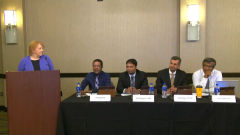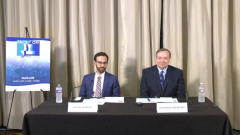
Relapsed/Refractory Multiple Myeloma: The ALLIANCE A061202 Study
Adeel Khan, MD, MPH, MS, expert in multiple myeloma management, reviews data from the ALLIANCE A061202 trial of isatuximab + pomalidomide + dexamethasone in relapsed/refractory disease.
Episodes in this series

Transcript:
Judy Schreiber, PhD, RN: We’re going to move on to the presentation by Dr Khan on the Alliance A061202 trial [NCT02004275]....
Adeel Khan, MD, MPH, MS: Thank you so much. Hello again, it’s my pleasure to be presenting the Alliance A061202 study. This is a phase 1/2 study of ixazomib [ixa], pomalidomide [pom], dexamethasone [dex], lenalidomide, and proteasome inhibitor [in patients with refractory myeloma]. These data were presented at the European Hematology Association 2022 annual meeting as well as at the International Myeloma Workshop. Some of the earlier data were published in American Journal of Hematology in 2021; we’re awaiting the final publication from this group to see some of the final numbers. Just to give a little bit of an overview of the study, this was a monthly centered trial, this was led by Peter Voorhees, Paul Richardson, and colleagues of a phase 1/2 study. The phase 2 component contained 77 patients who were treated with 28-day cycles consisting of pomalidomide given at 4 mg in days 1 to 21, a stratified dexamethasone dosing strategy of 20 mg for those aged greater than 75 years, or 40 mg for those less than 75 years on days 1, 8, 15, and 22. The intervention was randomized for patients to either receive ixazomib at 4 mg on days 1, 8, and 15, or no additional therapy, and for post registration we saw 38 patients receiving ixazomib and 39 patients receiving nothing further.
The eligibility criteria are notable here in that, unlike some prior data, this was trying to move ixazomib up in earlier lines of therapy. Patients had to have at least 1 prior line of therapy, had to be lenalidomide refractory, pomalidomide naïve, and it also ixazomib naïve. They had to be proteasome inhibitor [PI] naïve or sensitive, and that was defined briefly as having received a PI 6 months ago or earlier. ECOG performance status of less than 2 and without significant comorbidities were the usual [criteria] of what we see in clinical trials. The outcomes that they looked for were as follows: The primary end point was progression-free survival; secondary end points with explanatory end points included overall response rates, the clinical benefit rate that alters defined as overall response rate plus minimal response rate, overall survival, and safety parameters; and there were other exploratory outcomes. So what did they get? I should first say that the groups were well balanced in both arms in the ixa-pom-dex arm, the 38 patients, the average age was 66 years with a range of about 40 to 83. In the pom-dex arm of 39 patients, the average age was 64 years with a range of 52 to 85. The percentage of high-risk cytogenetics was roughly 40% in the study and it was slightly enriched for those at higher RISS [Revised International Staging System for Multiple Myeloma] staging. In terms of demographics, something which the authors were particularly pleased about was that there was a fairly high rate of [Black participants] of almost 15%, which is quite good for a lot of our trials. Looking at the PFS [progression-free survival] Kaplan-Meier curves, we saw that ixa-pom-dex, the solid line up the top, had a 20.3-month median survival with a range of about 8 to 31[months]. The pom-dex, the dashed line down below, had a median survival PFS of 7.5 months with a range of about 5 to 14 [months]. The hazard ratio was .35, and this was statistically significant. Looking at some of the secondary end points, this was the overall survival Kaplan-Meier curve set of ixa-pom-dex. The median was not reached since similarly, the pom-dex was also not reached. I should remind that this is a phase 2 study: This was not powered to look at overall survival, and that is usually a hard mark for myeloma treatments anyway.
Looking at some of the other results as well, the good partial remission rate was 26.3 [months] in ixa-pom-dex and in pom-dex it was 5.1. This also achieved statistical significance. The overall response rate was 63% in ixa-pom-dex versus 44% in pom-dex. This did not achieve significance, nor did the clinical benefit rate, again, defined as ORR [overall response rate] plus minimal response rate of 74% in ixa-pom-dex, and 56% in pom-dex. In terms of toxicity, as in discussing what treatment costed, these are the most prevalent grade 3 or 4 adverse events listed here: Most prominently, lymphopenia was seen in both arms, 40% in ixa-pom-dex, 26% in pom-dex; neutropenia of 37% in ixa-pom-dex, 21% in pom-dex; anemia and fatigue matched one another quite similarly, in ixa-pom-dex is 16% and 16% respectively, and 13% and 15% in pom-dex; discontinuation of treatment due to adverse events was identical at 8% in each arm; and discontinuation due to progressive disease showed more of a difference with 77% in pom-dex versus 47% in ixa-pom-dex. In terms of conclusions, I always feel that the best studies ask as many questions as they answer. We saw here that ixa added to pom-dex significantly increased the PFS in this population of refractory patients. This triplet was well tolerated; it would need confirmation in a well-powered phase 3 study. A note about this treatment is that it was all oral, which the authors celebrated. This was done, largely, during the COVID-19 pandemic, and while infection of COVID-19 was seen in both arms, they did not have any excess mortality in either. It begs the question of “Where does ixazomib fit in treatment sequencing?” Does this actually move it to second line or toward other lines of therapy? And now, post pandemic, is this all-oral regimen really such an advantage? And with that, I thank you all for your attention.
Transcript edited for clarity.
Newsletter
Stay up to date on recent advances in the multidisciplinary approach to cancer.




















































































